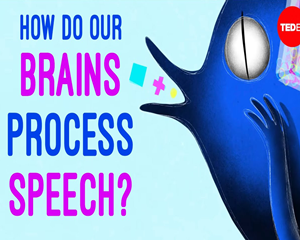The average 20 year old knows between 27,000 and 52,000 different words. By age 60, that number averages between 35,000 and 56,000.
20岁的普通人认识约27000到52000个单词。60岁时,这个数字平均会达到35000到56000之间。
Spoken out loud, most of these words last less than a second.
大部分这些词讲出来仅需不到一秒钟的时间。
So with every word, the brain has a quick decision to make: which of those thousands of options matches the signal?
因此每听到一个词时,大脑都要快速做出决定:在成千上万的选项中,到底哪个和接收到的信号相符?
About 98% of the time, the brain chooses the correct word. But how?
大约98%的情况下,大脑都能选出正确的词。但它是怎么做到的呢?
Speech comprehension is different from reading comprehension, but it's similar to sign language comprehension
言语理解与阅读理解不同,却与手语理解相似,
though spoken word recognition has been studied more than sign language.
尽管与言语辨识相关的研究比手语要多。
The key to our ability to understand speech is the brain's role as a parallel processor, meaning that it can do multiple different things at the same time.
我们能够理解言语的关键在于大脑的并行处理能力,也就是说,大脑可以在同一时间做多件不同事情。
Most theories assume that each word we know is represented by a separate processing unit that has just one job:
大多数理论都假设,我们所知道的每个词均由各自的处理单元掌管,每个单元唯一的任务
to assess the likelihood of incoming speech matching that particular word.
评估输入语音与该单元负责的词语相匹配的程度。
In the context of the brain, the processing unit that represents a word is likely a pattern of firing activity across a group of neurons in the brain's cortex.
在大脑中,每个单词的处理单元可能就是大脑皮层中的一群神经元的放电模式。
When we hear the beginning of a word, several thousand such units may become active, because with just the beginning of a word, there are many possible matches.
当我们听到词语的开头时,可能会有上千个这样的单元被激活,因为仅知道词语开头的话,是有很多种匹配可能的。
Then, as the word goes on, more and more units register that some vital piece of information is missing and lose activity.
随着单词的继续,越来越多的单元发觉它们缺失了一些关键信息,随即不再活跃。
Possibly well before the end of the word, just one firing pattern remains active, corresponding to one word. This is called the "recognition point."
可能早在单词结束之前,就只剩一种放电模式仍旧活跃,对应一个单词。这叫做“识别点”。
In the process of honing in on one word, the active units suppress the activity of others, saving vital milliseconds.
在逐渐筛选出一个词的过程中,活跃的单元会抑制其他单元的活动,节省关键的几毫秒时间。
Most people can comprehend up to about 8 syllables per second.
大多数人每秒钟能理解多达8个音节。
Yet, the goal is not only to recognize the word, but also to access its stored meaning.
但目标不仅仅是识别出单词,还要提取它储存的意思。

The brain accesses many possible meanings at the same time, before the word has been fully identified.
在完全辨认出单词之前,大脑已同时提取出很多可能的词义。
We know this from studies which show that even upon hearing a word fragment -- like "cap"
这是因为有研究显示,即使只听到一个单词片段,比如“cap”,
listeners will start to register multiple possible meanings, like captain or capital, before the full word emerges.
听者都会开始想到若干可能的词义,比如“captain”或“capital”,即使完整的单词还没有显现。
This suggests that every time we hear a word there's a brief explosion of meanings in our minds, and by the recognition point the brain has settled on one interpretation.
这表示每次听到一个单词时,我们的脑海中都会短暂地迸发出许多涵义,而等到了识别点时,大脑已经确认了一种释义。
The recognition process moves more rapidly with a sentence that gives us context than in a random string of words.
比起一连串随机词汇,识别过程能更迅速地辨识提供了语境的句子。
Context also helps guide us towards the intended meaning of words with multiple interpretations, like "bat," or "crane," or in cases of homophones like "no" or "know."
语境也能引导我们正确地理解多义词,比如“bat”或“crane”,或者同音字,比如“no”和“know”。
For multilingual people, the language they are listening to is another cue, used to eliminate potential words that don't match the language context.
对于掌握多种语言的人来说,他们在听的语言也是一种线索,能用来排除并不符合语言情景的待选单词。
So, what about adding completely new words to this system? Even as adults, we may come across a new word every few days.
那么把完全陌生的词加到这个系统中会怎样呢?即使作为成人,我们每几天也可能遇到一个新词。
But if every word is represented as a fine-tuned pattern of activity distributed over many neurons, how do we prevent new words from overwriting old ones?
但如果每个词都由分散在许多神经元中的精准的激活模式所控制,我们该如何避免新词覆盖旧词?
We think that to avoid this problem, new words are initially stored in a part of the brain called the hippocampus,
我们认为,为了避免这个问题,新词最初是储存在大脑中一个叫做“海马体”的区域,
well away from the main store of words in the cortex, so they don't share neurons with others words.
远离大脑皮层中的词汇主存储器,因此它们不会和其他单词共用神经元。
Then, over multiple nights of sleep, the new words gradually transfer over and interweave with old ones.
然后,经过几晚睡眠,这些新词会逐渐转移过去,和旧词交织在一起。
Researchers think this gradual acquisition process helps avoid disrupting existing words.
研究者们认为,这种渐进的习得过程能帮助避免扰乱现存的词汇。
So in the daytime, unconscious activity generates explosions of meaning as we chat away.
所以在白天,当我们聊天时,无意识的活动制造出了词义的礼花。
At night, we rest, but our brains are busy integrating new knowledge into the word network.
到了晚上,我们进入了睡眠,而大脑则会开始忙着把新知识整合进词汇网络中。
When we wake up, this process ensures that we're ready for the ever-changing world of language.
在我们醒来时,这个过程能确保我们为瞬息万变的语言世界做好了准备。


